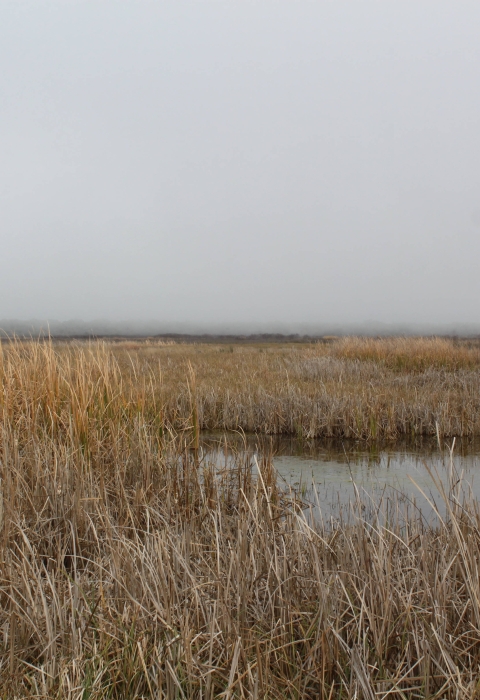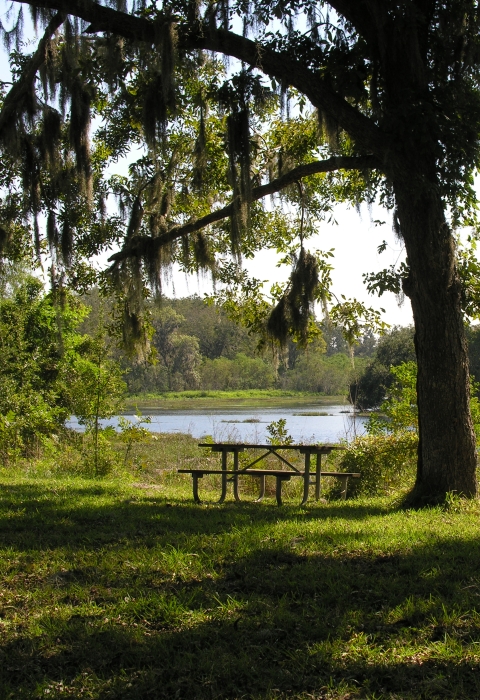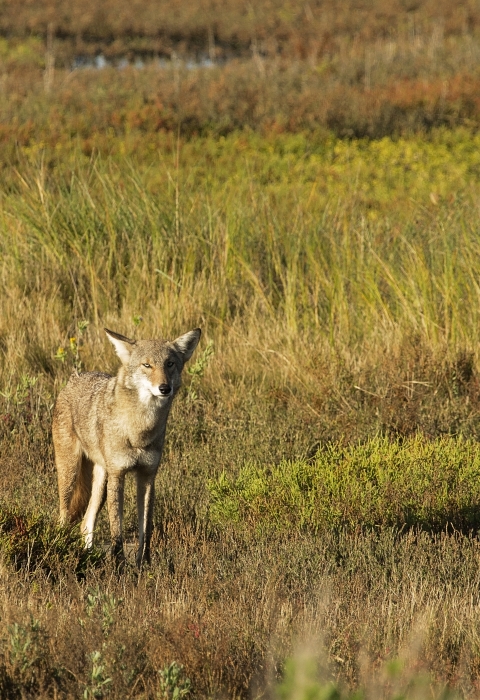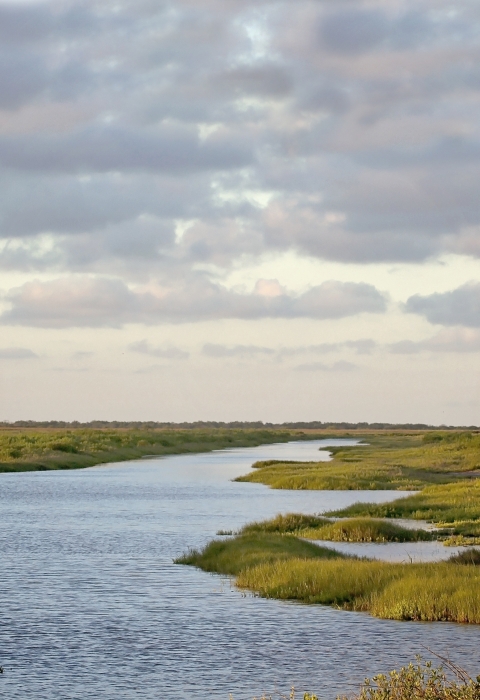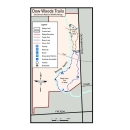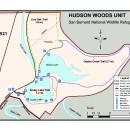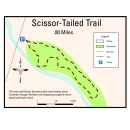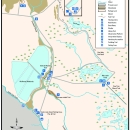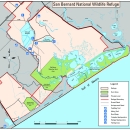Visit Us
National wildlife refuges offer us all a chance to unplug from the stresses of daily life and reconnect with our natural surroundings. Gazing across the refuge’s pristine marshes, sloughs, expansive uplands and into the woodlands, it is easy to imagine Texas as it was before settlement. Clouds of snow geese in the winter or warbler “fallouts” in the spring further convince visitors they have stepped back in time.
San Bernard National Wildlife Refuge has a variety of opportunities for visitors to get out and enjoy nature. The refuge has four miles of beach, accessible by boat or driving up from Sargent Beach. Countless migrating shorebirds, including the endangered piping plover and threatened red knot, share this shoreline with nesting Kemp’s Ridley sea turtles. The beaches’ dunes not only support a diversity of wildlife, but also provide a buffer to the bordering bay estuaries and saltwater marshes. These watery ecosystems sustain massive oyster beds and serve as nurseries for shellfish and finfish, an important source of food for great blue herons, roseate spoonbills, and wood storks. Recreationally important fish species, like red drum, speckled trout and gulf flounder, encircle the small islands crowded with nesting colonial waterbirds including black skimmers and reddish egrets.
From the Moccasin Pond Observation Deck in the Cocklebur Slough Recreation Area, gaze out across the vast estuary toward Cowtrap Lakes to see where the salty environment is diluted by the rivers and rainfall creating freshwater wetlands with cattails and rushes supporting purple gallinules, bitterns, frogs, crawfish, and alligators that sun themselves on the banks. Thousands of waterfowl fill these wetlands where they feed, rest, and build up the reserves needed for a winter stay or to complete their migration.
Along the banks of freshwater sloughs, creeks and rivers, the Columbia bottomlands forest stretches toward the Gulf of Mexico. These dense woods, made up of massive live oaks, water oaks, green ash, hackberry, and pecan trees, become dominant as you drive away from the marsh habitats. Bobcat Woods Trail and San Bernard Oak trail are near coastal forests that can fill with colorful migrating songbirds during a spring fallout. Exhausted from their flight across the Gulf, neotropical migratory birds depend on the bottomlands as a place to rest, feed and refuel before continuing their migration. The inland Dow Woods (north of Lake Jackson, Texas) and Hudson Woods (west of Angleton, Texas) Recreation Areas will show visitors why Steven F. Austin referred to the bottomlands of the Brazos and San Bernard Rivers as impenetrable cane break forests.
Fees
There is no charge to visit any of the public use areas.
Restrooms
Restrooms are available at the refuge Field Office and the trailhead of Bobcat Woods. Restrooms are also available at Dow Woods and Hudson Woods Recreation Areas.
Points of Interest
You can get information, maps and brochures at the visitor contact area inside the refuge Field Office and the entrance kiosk to Cocklebur Slough Recreation Area.
What To Do
If you have 15-minutes:
- Check out the Cedar Lake Creek Plantation Trail. Located across from the Texas Mid-coast National Wildlife Refuge Complex office on CR 316 and FM 2611, the short 1.1-mile trail runs alongside an ephemeral slough. View the McCroskey Log House which was constructed in 1824.
If you have one hour:
- The refuge offers a self-guided auto tour along a freshwater slough, Moccasin and Rail Ponds, the upper salt marshes and woodlands. The auto tour is a popular place for viewing alligators, waterfowl, wading birds and shorebirds.
- The Dow Woods Unit, just north of Lake Jackson, Texas, has 2.5 miles of walking trails along Bastrop Bayou under the canopy of a live oak forest.
If you have half a day or more:
- Enjoy some of the many trails. The Bobcat Woods Trail is an accessible boardwalk and trail in a riparian riparian
Definition of riparian habitat or riparian areas.
Learn more about riparian forest along Cocklebur Slough and overlooking the Wolfweed moist-soil units. Cow Trap Marsh Trail, located across from the Moccasin Pond Overlook is an old oil field road that take you deep into the salt marsh salt marsh
Salt marshes are found in tidal areas near the coast, where freshwater mixes with saltwater.
Learn more about salt marsh . San Bernard Oak Trail, located just west of the Cocklebur Slough Recreation Area is walk to a 300-year-old live oak tree.
Know Before You Go
Bring insect repellant in every season. Be prepared for the heat and sun by carrying drinking water and sunscreen.
Visitor Tips
Early morning and evening are the best time to view wildlife. The weekdays are less busy than weekends.
Activities
The Cedar Lakes Creek area offers saltwater fishing. The refuge offers exceptional wildlife viewing from the auto tour and trails. Waterfowl hunting is allowed seasonally in designated areas.
Trails
Bobcat Woods Trail and Boardwalk
- Open Season: Year-round
- Length: 2.5 miles
- Location of trail: Across from Moccasin Pond Loop
- Surface: Accessible boardwalk and concrete walk
- Difficulty: Easy
- Information: The loop trail includes a walk under riparian riparian
Definition of riparian habitat or riparian areas.
Learn more about riparian forest canopy and overlooking the Wolfweed Wetlands.
Cow Trap Marsh Trail
- Open Season: Year-round
- Length: 1.2 miles
- Location of trail: Beside Moccasin Pond Platform
- Surface: Gravel/grass
- Difficulty: Easy
Scissortail Trail
- Open Season: Year-round
- Length: 0.8 miles
- Location of trail: Off of entrance road
- Surface: Mowed path
- Difficulty: Easy
San Bernard Oak Trail
- Open Season: Year-round
- Length: 0.7 miles
- Location of trail: Off of CR 306
- Surface: Mowed path
- Difficulty: Easy, but boots needed when wet
Tveten Trail
- Open Season: Year-round
- Length: 0.9 miles
- Location of trail: Dow Woods
- Surface: Concrete
- Difficulty: Easy, accessible
Bastrop Bayou Loop
- Open Season: Year-round
- Length: 1.5 miles
- Location of trail: Dow Woods
- Surface: Crushed granite
- Difficulty: Easy
Scoby Lake Trail
- Open Season: Year-round
- Length: 1.4 miles
- Location of trail: Hudson Woods
- Surface: Mowed path
- Difficulty: Easy
Live Oak Trail
- Open Season: Year-round
- Length: 0.8 mile
- Location of trail: Hudson Woods
- Surface: Mowed path
- Difficulty: Easy
Oyster Creek Trail
- Open Season: Year-round
- Length: 2.7 miles
- Location of trail: Hudson Woods
- Surface: Mowed path
- Difficulty: Easy
Cedar Lake Planation Trail
- Open Season: Year-round
- Length: 1.1 miles
- Location of trail: Across from Complex Office on CR316
- Surface: Crushed Granite
- Difficulty: Easy
Related Documents
Rules and Policies
- No camping, fires, or fireworks
- Keep pets on leash
- To protect the fragile habitats and wildlife, off-road travel is not permitted
Locations
The Complex Office is the location where people can purchase the America the Beautiful Interagency passes. Please call (979) 964-4011 in advance to ensure that staff is available.
